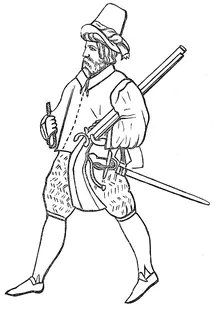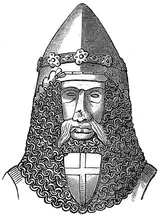![]()
C
CADDIS, CADDAS. A name given to a manufacture of worsted, probably mixed with woollen, and sometimes called “ cruel:” “ caddas, or cruel ribbon.” (‘Book of Rates,’ 1675, p. 293.) “ Caddas, or cruel sayette.” (Palsgrave.) It was used for stuffing dresses. In the third year of the reign of Edward IV. a sumptuary act was promulgated, by which no yeoman, or person under the degree of a yeoman, was allowed bolsters, or stuffing of wool, cotton, or cadis, in his pourpoint or doublet, under a penalty of six and eightpence fine, and forfeiture awarded.
CALABRERE. A fur, so called from Calabria, whence imported. “Pelles ex Calabria.” (Ducange in voce.)
“ His collar splayed and furred with ermyn, calabrere, or satin. (25, ‘Coventry Mystery.’)
Piers Ploughman describes a physician as clad in a furred hood and cloak of calabrere ; which Strutt explains as a costly sort of fur. Mr. Fairholt, without giving his authority, calls it a cloth; but the word pelles, used by Ducange, in allusion to a quotation from Rymer, “ Indumentum foderatur cum Calabria,” certainly implies skins or fur.
CALASH. (Calèche, French.) A hood, made like that of the carriage called in France calèche, to pull over the head, whence its name. It is said to have been introduced in England in 1765, if not invented by, the Duchess of Bedford. A similar article of apparel, however, appears to have existed long previously, examples of which are to be seen in the recumbent effigies of the sixteenth and seventeenth centuries. The calash may, therefore, have been, like many other things, an old fashion revived, with improvements, and a new name. (See HOOD and CLOAK.)
Calash.
From a print, dated 1780.
CALICO. A stuff made of cotton, and originally manufactured at Calicut, in India, whence its name. “ I can fit you, gentlemen, with fine calicoes too, for your doublets; the only sweet fashion now, most delicate and courtly; a meek, gentle calico, cut upon two double, affable tafatas.“ (Dekker, Honest Whore,’ 1604.) “Sir Martin Noel told us the dispute between him, as farmer of the additional duty, and the East India Company, whether callico be linnen or no, which he says it is, having been ever esteemed so. They say it is made of cotton woole, and grows upon trees, not like flax or hemp: but it was carried against the Company, though they stand out against the verdict.” (Pepys’ ‘Diary,’
sub. February 27,
.)
Calash.
From print after Bunbury.
CALIMANCO. A glazed woollen stuff, called by Lilly, in his ‘Midas,’ “calamance.” But see CAMAIL.
CALIVER. (Calibre, French.) A harquebuss, so called from the calibre or width of the bore, introduced in the reign of Elizabeth. “ Put me a caliver into Wart’s hands, Bardolph.” (Shakespeare’s ‘Henry IV.,’ Part II: act iii.) Edmund Yorke, a writer of that period, says, “Before the battel of Mounguntur [Monconteur] in 1569, the Princes of the Religion caused seven thousand harquebuzes to be made, all of one calibre, which was called ‘Harquebuse de calibre de Monsieur Prince’; so I think some man, not understanding French, brought hither the name of the height of the piece, which word ‘calibre’ is yet continued with our good cannoniers.” (Maitland’s ‘History of London.’)
The caliver in the Tower Armoury, brought from Penshurst, is four feet ten inches in length. It was lighter and shorter than the musket, and had the advantage of the latter in being fired without a rest, and much more rapidly. As the width of the bore gave its name to the piece, the piece in its turn gave its name to the troops armed with it, who were called “calivers.” Mr. Hewitt observes that the caliver seems to have gone out of fashion soon after 1630, for Hexham, in 1637, says, “forasmuch as of late yeares there are noe callivers in a foot companie,” &c.
CALLOT. (Calotte, French.) A small coif or cap. The little black cap worn by the Roman Catholic clergy is so called. Canons were prohibited from wearing them of linen in the streets, A.D. 1259. (Statuta Eccl. Aquens, sub anno.)
CAMACA. See CAMMAKA.
Caliver-man. From the roll of the funeral of Sir Philip Sidney. 1586.
CAMAIL (French; camallus, Latin; cameglio, Italian.) The derivation of this word is very uncertain; but the probabilities are in favour of its having the same source as “camlet,” “calimanco,” and other stuffs which were imitated from a finer material made of camel’s hair. (Vide Ducange in voce Camelaucum.) It was originally a sort of cape worn by ecclesiastics of the highest order: “ Camelaucus, vestimentum Papae ”; and sometimes ornamented with precious stones: “ Occidit Totilam et vestimenta ejus cruentata cum camilaucio lapidibus preciosis ornato misit Constantinopolim.” (Anas-tatius, in Hist. Eccles.) The term was afterwards applied to the protection for the neck and shoulders of chain mail attached to the basinet, when that head-piece was introduced in the fourteenth century (see under BASINET) ; and it has therefore been suggested that “ camail ” was simply a corruption of “ cap-mail.” The undoubted fact, however, of a similarly shaped vestment having been previously worn by the clergy, and made of camel’s hair, I think justifies me in pointing out this as one of the many instances in which the name of one article of apparel becomes transferred to another, very often entirely differing from it in shape and texture. In the accounts of Etienne de la Fontaine, the French king’s silversmith, 1349, there is the following entry: “Pour six onces de soie de divers couleurs, a faire les las a mettre les camaux aussdits bacinets.” Towards the end of the fourteenth century these silken cords were covered with metal borders, richly engraved and sometimes jewelled. (Vide Plate III. fig. 9.) The effigy of Sir Henry FitzRoger, in Newton-Mendip Church, Somersetshire, affords us an example of the ornamentation of the camail itself. A shield charged with a St. George’s cross is fixed on it immediately under the chin. If made of steel, it would be an additional defence to the throat.
Camail.
From effigy of Sir Henry FitzRoger.
CAMBRIC, CAMERICK. This well-known material appears from Stow to have been first introduced into England in the reign of Queen Elizabeth; and Philip Stubbs, in his ‘Anatomie of Abuses,’ printed at London, A.D. 1595, tells us that it was chiefly used for the great ruffs then in fashion with both sexes, and was so fine that “the greatest thread was not so big as the smallest hair that is.” Bands, cuffs, handkerchiefs, and shirts, were also made of it.
“ His shirt had bands and ruff of pure cambrick.”—Thynne’s Debate between Pride and Lowliness.
“ You velvet, cambricke, silken-feathered toy! ”—S. Rowland’s Look to it, for I’ll Stabbe ye. 1604.
CAMELINE. A stuff made of camel’s hair. (Halliwell, in voce.) But the derivation of this and similar names of several other sorts of material requires confirmation. Cameline is mentioned as early as the thirteenth century:
“ The cloth was ryche and rygt fyn,
The champe [field] it was of red camelyn.”
Roman de la Rose, 1. 7367.
It is quite possible it may have been a manufacture similar to what we now call “ cashmere,” and imported from the East. (See under CAMAIL, CAMLET.) M. le-Duc, however, contends that cameline was an inferior species of manufacture, of Phenician origin, and quotes Joinville, who says “the king [Louis IX.] sent him to Tortosa, and commissioned him to purchase for him one hundred camelins of divers colours, to give to the Cordeliers when they returned to France.” He asserts also, that it was always spoken of as a very common stuff, “ une étoffe très-ordinaire,” in which he is certainly contradicted by the above quotation, wherein it is described as “ rich and right fine.” He admits, however, that in the thirteenth century camelines were made at St. Quentin...





